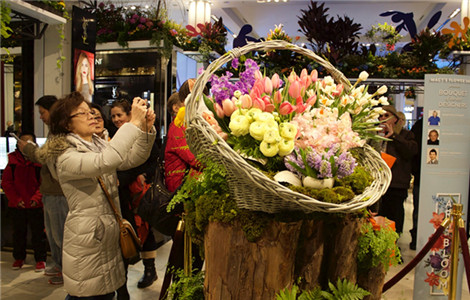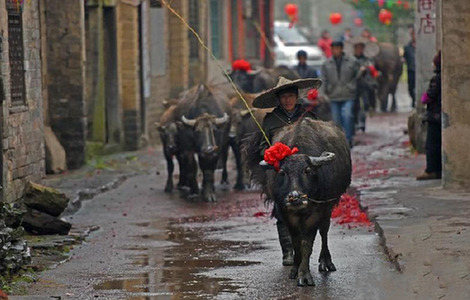New city design can help reclaim a lost way of life
Updated: 2015-03-18 05:19
By Chris Davis(China Daily USA)
|
||||||||
When landscape architect Sean O'Malley finds himself on a site for the first time, he looks for what stands out, what defines the place. Working on the scale that he does as managing principal of Laguna Beach, California-based firm SWAGroup, this could often mean a mountain, a river, a system of wetlands. Whatever it is that defines the landscape's character.
"I look for the environmental system," he said, "the armature from which residential, retail, office or civic uses can grow and evolve over time."
Case in point: the Shunde New City Plan, located at the Pearl River Delta, and hour-and-a-half ferry ride from Hong Kong and the second-largest bird migration delta and estuary in Southeast Asia.
In the race toward development in one of the fastest growing regions on the planet, the area had, by 2008, become a low-lying, levee city like New Orleans and China wanted it turned into a city for 2 million people with a one-square-kilometer reservoir.
SWA won the Shunde New City project by beating teams from Germany, France, Singapore and Beijing in an international competition.
SWA's 95-square-kilometer plan, approved in 2010, made room for people and birds by weaving a delta wetland into a pedestrian-oriented city. Its website calls it an example of a project at "the pinnacle of today's development challenges".
The solution is what landscape architects call a "sponge city", an area "that can absorb excess water, keep it on site and return it to the ground water table right there beneath your feet and treat the water in the natural way and reduce runoff", O'Malley said.
O'Malley studied the site and saw that it originally had been a delta with a network of small waterways, all of which had been channelized into two main rivers that flanked and edged the site behind big levees.
"The same thing we did in the Mississippi River Valley, China has done in southern China. So we share the same unfortunate landscape history," he said.
"In southern China, life used to revolve around the edge of the water, people would gather beneath the fichus tree along these narrow waterways and chat and wash their clothes and drink the water all from the little canals," he said.
Here all those little canals had been pushed out and made into two giant rivers and, as O'Malley puts it, "Who wants to be on the edge of a giant river?"
The Pearl River Delta was one of the fastest growing regions in the world, "but because they went so fast, they got a lot of environmental problems," said Xiao Zheng, another principal at SWA who has been working on the project.
Channelizing rivers creates a host of problems: it directs the water and deepens it in a way that makes it flow faster, it creates erosion and worst of all leaves no flexibility when nature decides to release a torrent of rainfall upstream and the floods come.
O'Malley's team came up with an idea. Why not take the reservoir they want and stretch it out, rebuild the delta and create a series of walkable water towns and islands each of which can grow in a natural way.
"Restore the lost waterways, the lost water towns," he said. "Most importantly, restore the lost water culture."
They linked all the islands and waterways as both transportation and recreation, with parks and bike trails so kids could ride their bikes to school, and put wetlands along the way to help clean and filter the water.
"As the river now passes through the city, the city feels like a lung of the river, breathing new life, new dissolved oxygen into the river," O'Malley explained.
The two central business districts are now anchored by a high-speed rail, one of the first things to be built, and a highway, and then the waterfront, the linear park system as a catalyst for development. A civic center and government offices have opened and a small college is slated for expansion into a university.
O'Malley said a lot of SWA's ideas come from the US' culture, where the landscape is front and center. "It defines who we are," he said. "We've made mistakes before and we're coming at it from that angle, bringing that knowledge to China."
"We learn from the mistakes and the lessons learned from the Western countries," Xiao said.
O'Malley said selling their ideas has not been too difficult because he feels the Chinese like the idea of landscape and are "very accepting of Nature and that story".
"Traditionally it's been a part of their past and they've lost it and they know that, as they've developed so quickly," he said.
"Also," Xiao added, "a lot of our clients are very open minded. They like bold ideas."
Contact the writer at chrisdavis@chinadailyusa.com.

 Top 10 young Chinese entrepreneurs defining the future
Top 10 young Chinese entrepreneurs defining the future
 China joins legendary flower show
China joins legendary flower show
 Monks perform tea-picking ritual in Hangzhou
Monks perform tea-picking ritual in Hangzhou
 Singapore founding father Lee Kuan Yew
Singapore founding father Lee Kuan Yew
 5 things you may not know about the Spring Equinox
5 things you may not know about the Spring Equinox
 Solar eclipse wows viewers
Solar eclipse wows viewers
 New Year Carnival thrills Vancouver
New Year Carnival thrills Vancouver
 Across America over the week (from March 13 to 19)
Across America over the week (from March 13 to 19)
Most Viewed
Editor's Picks

|

|

|

|

|

|
Today's Top News
Beijing artist gives back to opera
Lee remembered as 'old friend' of Chinese people
Texas Republican Cruz announces presidential bid
Fictional TV presidents more popular than Obama - poll
Funding of China-backed bank will be open to other countries
Six Western economies apply to join AIIB
US urged to honor pledge
Ex-wife of Chinese fugitive
to be released
US Weekly

|

|








